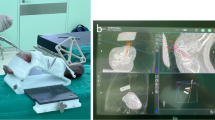Abstract
Purpose
Conventional navigated surgery relies on placement of a reference marker on the anatomy of interest. However, placement of such a marker is not readily feasible in small anatomic regions such as the scaphoid bone of the wrist. This study aimed to develop an alternative mechanism for patient tracking that could be used to perform navigated percutaneous scaphoid fixation.
Methods
A prototype wrist stabilization device was developed to immobilize the scaphoid relative to a reference marker attached to the device. A position measurement system and 3D fluoroscopy were used to study the accuracy and limitations of wrist stabilization during simulated clinical usage with a cadaver specimen. Reference markers mounted on the device were used to measure intra-device motion. Radiometallic beads implanted in the scaphoid were used to measure patient-device motion. Navigated planning and guidance of scaphoid fixation were performed in five cadaver and eight “ideally immobilized” plastic specimens. Postoperative 3D fluoroscopy was used to assess the accuracy of navigated drilling.
Results
The average intra-device motion was 1.9 mm during load application, which was elastically recovered upon release of the load. Scaphoid motion relative to the reference marker was predominately rotational with an average displacement of 1.25 mm and \(2.0^{\circ }\). There was no significant difference in the accuracy of navigated drilling between the cadaver specimens and the ideally immobilized group.
Conclusions
The prototype wrist stabilization device meets the criteria for effective wrist stabilization. This study provides insight concerning proper use of the device to minimize scaphoid displacement and design recommendations to improve immobilization.






Similar content being viewed by others
References
Langlotz F, Nolte L-P (2004) Technical approaches to computer-assisted orthopedic surgery. Eur J Trauma 30(1):1–11. doi:10.1007/s00068-004-1374-0
Liverneaux PA, Gherissi A, Stefanelli MB (2008) Kirschner wire placement in scaphoid bones using fluoroscopic navigation: a cadaver study comparing conventional techniques with navigation. Int J Med Robot 4(2):165–173. doi:10.1002/rcs.194
Walsh E, Crisco JJ, Wolfe SW (2009) Computer-assisted navigation of volar percutaneous scaphoid placement. J Hand Surg Am 34(9):1722–1728. doi:10.1016/j.jhsa.2009.08.009
Niederwanger C, Wildmann G, Knoflach M, Schullian P, Hoermann R, Bale R (2012) Kirschner wire placement in scaphoid bones using intraoperative CT-guided stereotaxy. Minim Invasive Ther Allied Technol. (Epub ahead of print). doi:10.3109/13645706.2012.724688
Citak M, O’Loughlin PF, Kendoff D, Suero EM, Gaulke R, Olivier LC, Krettek C, Hufner T (2010) Navigated scaphoid screw placement using customized scaphoid splint: an anatomical study. Arch Orthop Trauma Surg 130(7):889–895. doi:10.1007/s00402-010-1044-0
Smith EJ, Al-Sanawi HA, Gammon B, St John PJ, Pichora DR, Ellis RE (2012) Volume slicing of cone-beam computed tomography images for navigation of percutaneous scaphoid fixation. Int J Comput Assist Radiol Surg 7(3):433–444. doi:10.1007/s11548-011-0634-9
Smith EJ, Oentoro A, Al-Sanawi H, Gammon B, Pichora DR, Ellis RE (2010) Calibration and use of intraoperative cone-beam computed tomography: an in-vitro study for wrist fracture. Med Image Comput Comput Assist Interv 13(3):359–366
Horn BKP (1987) Closed-form solution of absolute orientation using unit quaternions. J Opt Soc Am A 4(4):629–642. doi:10.1364/JOSAA.4.000629
Northern Digital Inc. (2006) Optotrak certus user guide. Revision 2. Northern Digital, Waterloo, Canada
Wiles AD, Thompson DG, Frantz DD (2004) Accuracy assessment and interpretation for optical tracking systems. Proc SPIE Med Imaging Vis Image Guid Proced Disp 5367:421–432. doi:10.1117/12.536128
Smith R, Self M, Cheeseman P (1990) Estimating uncertain spatial relationships in robotics. In: Cox IJ, Wilfong IJ (eds) Autonomous robot vehicles, vol 4. Springer, New York, pp 167–193
Acknowledgments
The authors wish to acknowledge Mr. Paul St. John for provided software support for the navigation interface used in this study.
Conflict of Interest
None.
Author information
Authors and Affiliations
Corresponding author
Rights and permissions
About this article
Cite this article
Smith, E.J., Allan, G., Gammon, B. et al. Investigating the performance of a wrist stabilization device for image-guided percutaneous scaphoid fixation. Int J CARS 9, 155–164 (2014). https://doi.org/10.1007/s11548-013-0834-6
Received:
Accepted:
Published:
Issue Date:
DOI: https://doi.org/10.1007/s11548-013-0834-6




